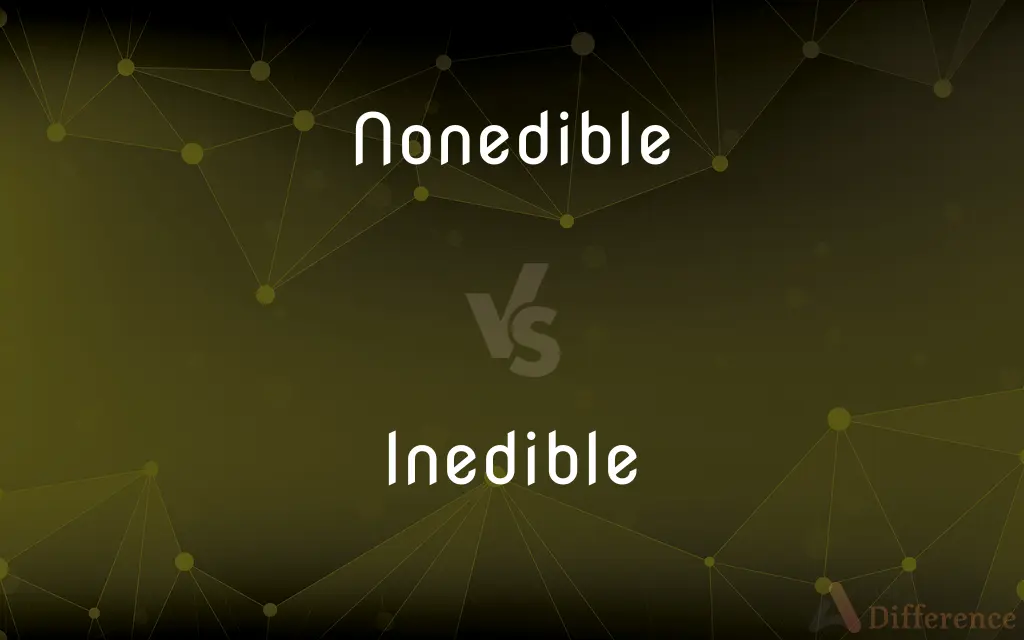Nonedible vs. Inedible — What's the Difference?
Edited by Tayyaba Rehman — By Urooj Arif — Updated on April 1, 2024
Nonedible refers to items not suitable for consumption, often due to lack of nutrition, while inedible suggests toxicity or harm if consumed.

Difference Between Nonedible and Inedible
Table of Contents
ADVERTISEMENT
Key Differences
Nonedible items are those not intended for consumption, often because they offer no nutritional value or are not part of a typical diet, such as paper or wood. Whereas, inedible items are not only unsuitable for eating but may also be harmful or toxic if ingested, such as poisonous plants or chemicals.
The term nonedible often applies to items that, while not food, do not pose a direct risk if consumed in small quantities, such as gum wrappers or crayons. On the other hand, inedible is used to describe substances that could lead to illness or worse, emphasizing the danger associated with consuming them.
In everyday conversation, nonedible is used to describe things that one could physically chew and swallow but shouldn't, due to lack of nutritional content or cultural norms against eating such items. In contrast, inedible often carries a stronger connotation, warning against consumption due to potential harm.
Regulatory labels and safety warnings might categorize products as nonedible to inform consumers that, despite being non-toxic, these items are not food and should not be eaten. Inedible products, however, are likely to come with more stringent warnings about the risks of poisoning or contamination, highlighting the importance of avoiding ingestion.
Understanding the distinction between nonedible and inedible can be crucial in contexts such as food safety, childproofing, and pet care, where the potential for accidental ingestion of harmful substances exists. While nonedible items may be safely kept within reach of children and pets under supervision, inedible substances require stricter precautions to prevent accidental consumption.
ADVERTISEMENT
Comparison Chart
Definition
Not suitable for consumption due to lack of nutrition
Harmful or toxic if consumed
Examples
Paper, wood, crayons
Poisonous plants, chemicals
Risk Level
Low, often not harmful in small quantities
High, can cause illness or worse
Usage Context
Items not intended as food but not dangerous
Substances that must be avoided due to potential harm
Regulatory Implications
Labeled to inform they are not food but non-toxic
Labeled with warnings about the risks of poisoning or contamination
Compare with Definitions
Nonedible
Generally safe if accidentally ingested in small amounts.
Although nonedible, the play dough is non-toxic for children.
Inedible
Indicates that something is harmful or toxic if eaten.
The berries were inedible and could cause serious illness if ingested.
Nonedible
Not intended for consumption, typically due to lack of nutritional value.
The sculpture was made of nonedible materials like clay and wire.
Inedible
Directly implies potential for harm upon consumption.
Inedible mushrooms often resemble their edible counterparts, posing a risk.
Nonedible
Often applies to products outside the food industry.
Nonedible glitter is used for decorating greeting cards and crafts.
Inedible
Knowledge of inedible substances is crucial for safety.
Teaching children about inedible household items is a key part of childproofing.
Nonedible
Often used to clarify that an item, while not toxic, is not food.
The decorations are nonedible and meant only for visual appeal.
Inedible
Products are clearly labeled to prevent accidental ingestion.
The chemical cleaner is inedible and stored safely away from food items.
Nonedible
Includes items that might be mistaken for food but aren't.
The nonedible cake ornament should be removed before serving.
Inedible
Can apply to both naturally occurring substances and manufactured products.
Some inedible plants are used for their medicinal properties, not for consumption.
Nonedible
Inedible
Inedible
Not fit or suitable for eating
An inedible variety of mushroom
Nonedible
Inedible
Inedible
Unfit to be eaten; not edible.
Inedible
Not edible; not appropriate, worthy, or safe to eat
Inedible
Anything inedible; that which is not a foodstuff.
Inedible
Not edible; not fit for use as food.
Inedible
Not suitable for food
Common Curiosities
What does nonedible mean?
Nonedible refers to items that are not suitable for eating, often because they lack nutritional value or are not intended as food.
How is inedible different from nonedible?
Inedible items are not only unsuitable for consumption but also harmful or toxic if ingested, whereas nonedible items are not intended for consumption but typically aren't harmful if accidentally eaten in small amounts.
Can something be nonedible but not inedible?
Yes, many objects are nonedible, meaning they are not food, but they are not necessarily inedible, as they do not pose a health risk if ingested in small quantities.
How can one ensure safety around nonedible and inedible items?
Safety can be ensured by proper storage, clear labeling, and education on the dangers of inedible substances and the proper handling of nonedible items.
What are some inedible substances that should be avoided?
Inedible substances include poisonous plants, chemical products, and certain fungi that can cause serious health issues if consumed.
Are all inedible items toxic?
While not all inedible items are toxic in the sense of being poisonous, they are harmful enough to cause illness or discomfort if consumed, and thus should be avoided.
What are common examples of nonedible items?
Common nonedible items include craft supplies like glitter, play dough, and certain decorative items not designed for consumption.
How should nonedible items be stored in comparison to inedible items?
Nonedible items should be kept out of reach of children and pets to avoid accidental ingestion, while inedible items require stricter precautions, such as locked storage, due to their potential harm.
Is labeling important for distinguishing between nonedible and inedible items?
Yes, clear labeling is crucial to inform consumers of the nature of the products, especially to prevent accidental ingestion of inedible substances.
Why is it important to understand the difference between nonedible and inedible?
Understanding the difference is important for health and safety, especially in preventing accidental ingestion of harmful substances and in educating others about what is safe to consume.
Share Your Discovery

Previous Comparison
Was vs. Were
Next Comparison
Perfunctory vs. PeremptoryAuthor Spotlight
Written by
Urooj ArifUrooj is a skilled content writer at Ask Difference, known for her exceptional ability to simplify complex topics into engaging and informative content. With a passion for research and a flair for clear, concise writing, she consistently delivers articles that resonate with our diverse audience.
Edited by
Tayyaba RehmanTayyaba Rehman is a distinguished writer, currently serving as a primary contributor to askdifference.com. As a researcher in semantics and etymology, Tayyaba's passion for the complexity of languages and their distinctions has found a perfect home on the platform. Tayyaba delves into the intricacies of language, distinguishing between commonly confused words and phrases, thereby providing clarity for readers worldwide.
















































